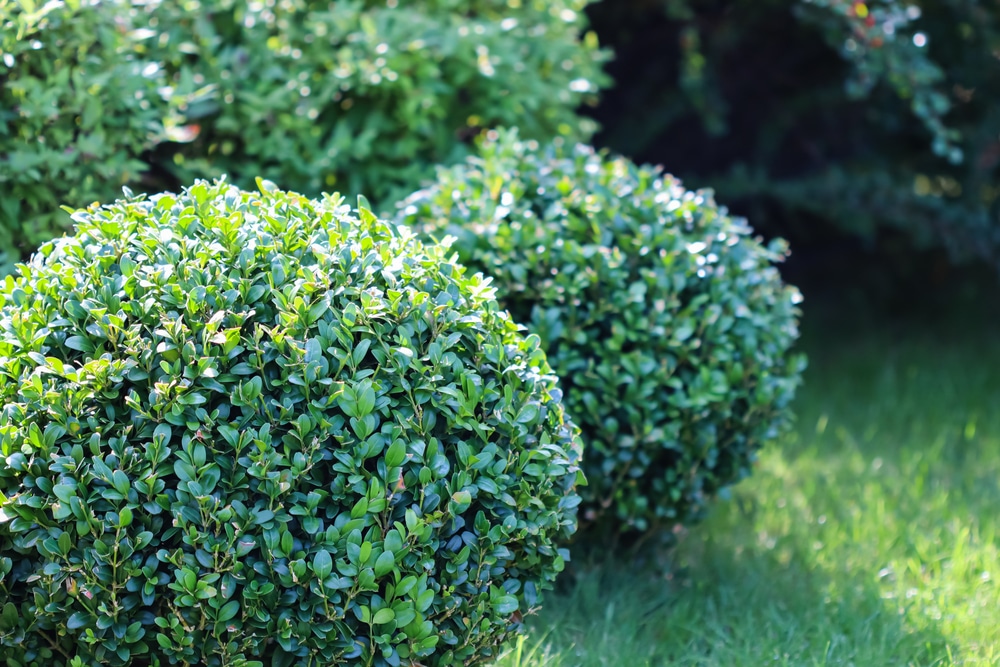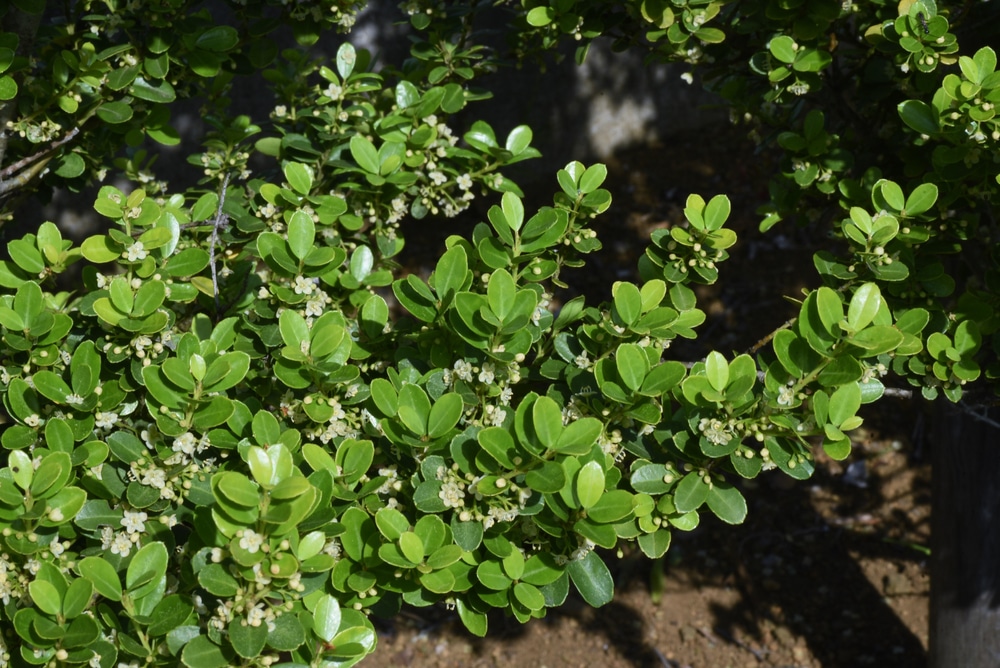
Managing weeds can be tricky if you have no borders around the fence. Gardeners worldwide can’t complain enough about weeds growing beneath the fences, even though using rubber sheets and layering bricks beneath the fence can fix your issues.
To cover up the layering or for other decorative purposes, gardeners like to grow shrubs against fences.
So, if you’re thinking about growing shrubs, let us help you with a few options that will look perfect for growing against your garden fence.
Can shrubs effectively help cover a fence?
Shrubs can be a great way to cover up an unsightly fence or create a beautiful natural barrier around your property.
If you’re looking for ways to enhance the look of your yard without spending too much money, shrubs are one of the best options. They come in all shapes and sizes, making them very versatile.
When planting shrubs around a fence, it’s essential to consider the height of the fence and how your chosen plants will affect its visibility.
For example, if you have a tall fence needing coverage, you should choose taller shrubs like holly or boxwood.
Shorter fences may benefit from shorter shrubs like barberry or rosemary. Once you’ve chosen the right plants for your fence, there are a few tips to maximize their effectiveness.
Make sure you plan and consider any potential growth of your shrubs. This way, they won’t overtake your fence over time and become more challenging to manage.
It’s also important to consider the soil conditions in your area so that you can choose shrubs that are well suited for it.
Different species of shrubs require different water levels, sunlight, and other environmental factors to thrive.
When planting shrubs around a fence, make sure you plant them at least a foot away from the fence.
This will ensure they have enough room to grow and won’t become too crowded. You may want to consider installing a trellis or other structure behind the shrubs to provide additional support.
Shrubs can also be used to create a natural barrier around your property.
Planting them in strategic places can help create a sense of privacy and security while also adding to the beauty of your landscape.
It’s important to consider the maintenance needs of your shrubs. Regular pruning is essential for keeping them healthy and looking their best. You may also want to fertilize them with the appropriate type of fertilizer.
The Best Available Options
There are many options available for shrubs to grow against a fence. However, it would help to look at your local environmental and soil conditions before deciding on a plant.
The surefire method would still be to decide on a plant that can tolerate extreme conditions while growing efficiently in your garden soil.
Ask your local gardeners about their experience with different shrubs, and then based on their plants, you can copy techniques that have worked out for other gardeners.
Evergreen Azalea is one of the favorite shrubs that gardeners like to grow against their fences. This shrub looks perfect with its vibrant colored flowers and deep-colored foliage.
Evergreen Azaleas are relatively easy to handle as long as you know about proper care tips and requirements.
There is not too much pruning required, and this shrub substantially boosts the beauty of your garden.
Aside from the Evergreen Azalea, Boxwood is also very popular. Gardeners are especially fond of this shrub because it easily controls the plant’s size and shape.
If you want to create a complete border of shrubs or develop an excellent and rounded shape, then the boxwood is the perfect fit for your garden. Once the shrub has grown enough, you can prune it quickly to add to the beauty of your garden.
However, Evergreen Azalea is a better option if you’re looking for something with more vibrant colors and lovely flowers.
It all comes down to what you plan to achieve with the shrubs. Boxwood will be more appropriate if you want some shrubs to cover the fence.
But if you don’t want to bother with pruning and managing shrubs too much, go with Evergreen Azalea. This will help you decide which shrub you want to grow in your garden.
What Shrubs are ideal for growing against a fence?
One of the most popular choices for growing shrubs against a fence is evergreen varieties.
Evergreen shrubs feature lush, green foliage year-round and create an attractive backdrop on any property. Some of the best options for evergreen shrubs include boxwood, yew, holly, privet, juniper, and arborvitae.
Boxwood is a widely used shrub for foundation plantings and hedges, making it an ideal choice for creating privacy along a fence line. These shrubs are available in both dwarf and large varieties that range from 1 to 20 feet tall.
Yew features fine-textured foliage that can be used to create privacy along a fence line. These evergreens also produce attractive red berries, adding an extra color to your landscape.
Holly is another evergreen shrub suitable for growing against a fence. These shrubs feature glossy green foliage and bright red berries, adding color to your landscape during winter.
Privet (Ligustrum spp.) is a fast-growing shrub that creates privacy along fences, walls, and other surfaces.
Juniper is an evergreen shrub with dense foliage that can create privacy along fences and walls. Junipers prefer full sun.
Arborvitae is an evergreen shrub often used to create privacy along fences and walls. These plants prefer full sun or partial shade and well-draining soil. They come in various sizes, from dwarf varieties that are only 2 feet tall to larger trees that can reach 25 feet in height.
In addition to evergreens, other shrubs such as viburnum and barberry can also create privacy along a fence line.
What to keep in mind when growing shrubs against a fence?
Shrubs are a great addition to any backyard and can be used to create an attractive, natural-looking fence.
But before you start planting shrubs against your fence, there are some things to keep in mind that will ensure the health and longevity of your plants and your fence.
Consider the type of shrub you’d like to use. Different types of shrubs have different needs and requirements in terms of the amount of sunlight and water they need and their size and shape when fully grown.
Select a type that fits your space and looks good against your fence.
Next, prepare the soil before planting your shrubs. Loose, well-draining soil is ideal and will allow the plants to get enough air and water. If needed, amend the soil with compost or fertilizer to increase its nutrient content.
When planting your shrubs against a fence, leave enough space between each plant to grow properly. Too much crowding can lead to disease due to a lack of air circulation, making it difficult for the plants to get enough sunlight.
To ensure healthy growth, give your shrubs regular maintenance. This includes pruning away dead or diseased branches, removing weeds that may spring up between the roots, and fertilizing when necessary.
Keep an eye out for any pests that may cause harm to your shrubs, as well.
When growing shrubs against a fence, consider using a trellis or other support structure. This will protect the plants from high winds and help keep them upright and strong.
Be mindful of the growth potential of each plant. Some plants can become very large when fully grown and could damage your fence, so check the size of each shrub before planting.
Also, it’s important to keep an eye on the appearance of your fence over time. If the paint is fading or chipping due to sun exposure or other factors, you may consider repainting or refinishing the fence.
Consider any local regulations or restrictions that may apply to your area when planting shrubs against a fence.
To Conclude
Boxwood and Evergreen Azalea are two of the most famous shrubs gardeners like to plant near fences. So, if you are looking for increased privacy or just want to decorate the garden, you can choose between either of these two options.
Evergreen Azalea has a more vibrant color and attractive-looking flowers. These shrubs look beautiful and don’t require as much attention.
Moreover, you will only have to prune them as often as boxwood. However, if you’re looking for increased control over the shape of your shrub, then boxwood provides a better platform.
Make sure to also get recommendations from your local gardeners to account for weather variations and soil conditions.



